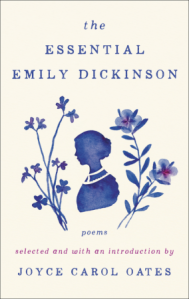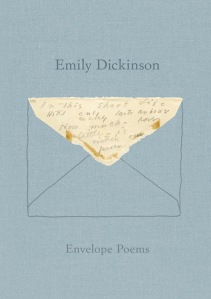 I am in the mood to read Emily Dickinson.
I am in the mood to read Emily Dickinson.
Unable to find my copy of The Complete Poems because of the recent black mold chaos of moving bookshelves, I ordered a lovely little book, The Essential Emily Dickinson, edited by Joyce Carol Oates. Oates’ introduction is erudite and witty: she begins with a comparison of Dickinson and Walt Whitman.
Between them, our great visionary poets of the American nineteenth century, Emily Dickinson (1830-1886) and Walt Whitman (1819-1892) have come to represent the extreme, idiosyncratic poles of the American psyche: the intensely inward, private, elliptical and “mystical” (Dickinson); and the robustly outward-looking, public, rhapsodic and “mystical” Whitman. One declares, “I’m nobody! Who are you?” The other declared: “Walt Whitman, an American, one of the roughs, a kosmos…”
I must reread Whitman, too. By the way, I loved the “I’m nobody!” poem in junior high.Remember those gigantic anthologies we staggered to English class with? Walt Whitman wasn’t in it. Too gay?
Emily Dickinson is very fashionable these days. Well, she was never out of fashion. But who would have guessed my decision to read Emily would coincide with the publication of Dan Chiassan’s essay (Dec. 5, 2016) in The New Yorker, “Emily Dickinson’s Singular Scrap Poetry.” He writes,
The poems of Emily Dickinson began as marks made in ink or pencil on paper, usually the standard stationery that came into her family’s household. Most were composed in Dickinson’s large, airy bedroom, with two big windows facing south and two facing west, at a small table that her niece described as “18-inches square, with a drawer deep enough to take in her ink bottle, paper and pen.” It looked out over the family’s property on Main Street, in Amherst, Massachusetts, toward the Evergreens, her brother’s grand Italianate mansion, nestled among the pines a few hundred yards away. Dickinson had a Franklin stove fitted to a bricked-up fireplace to keep her warm, which meant that she could write by candlelight, with the door closed, for as long as she wanted. In much of the rest of the house, the winter temperature would have been around fifty degrees. Though she usually composed at night, Dickinson sometimes jotted down lines during the day, while gardening or doing chores, wearing a simple white dress with pockets for her pencils and scraps of paper. A younger cousin recalled her reciting the “most emphatic things in the pantry” while skimming the milk.
I also learned that New Directions has published two books about the scraps, Envelope Poems and The Gorgeous Nothings, both edited by Jen Bervin and Marta Werner. I’d love to have these! Oh, well, after my Dickinson marathon, and if I can find The Complete Poems in one of my boxes.
LITERARY LINKS
1. William Trevor died last week. You might want to read George O’Brien’s excellent article in The American Scholar, “Injurious Entanglements: Remembering William Trevor’s Anglo-Irish Stories.” Here is an excerpt:
William Trevor, who died on November 20,is conventionally and conveniently thought of as an Anglo-Irish writer. But to consider him in that way is less to apply the finality of a category than to initiate an exploration of the distinctive significance of his work. It’s true that, in a literal sense, Trevor was Anglo-Irish. Born William Trevor Cox in 1928 in Mitchelstown, County Cork, he was reared and educated in Ireland. But his adult life was spent in England, first in London, then in Devon. Yet, the hybrid identity that the Anglo-Irish label typically brings to mind, together with its divisions and fidelities, is only one of many contexts featured in the body of work produced during the 50 years of Trevor’s prolific career.
2 In The Rumpus, there is an interview with novelist Alice Mattison about her new book on writing.
Mattison’s newest book, The Kite and the String, is a meditation on her lifelong journey through the craft of writing. Taking a balanced approach of warmth and realism, she welcomes readers into a conversation about not only what makes for good writing but also of the necessary balance between the independent, solitary writer and the social writing community. She draws upon her years as a poet and prose writer, supported by her many decades of teaching children and adults alike. Accessible and unbiased, Mattison is an encouraging guide for new and seasoned writers; she is cautious in advising that a strategy of success for one will easily not work for all, but pushes her readers to try most anything that may better enhance their work. Nerves are to be harnessed and channeled into production, while the quieter, more sedentary moments between writing spurts must be equally cared for and valued. We are reminded through wit and honesty that a career in creative writing is most certainly an uphill endeavor with innumerable and unpredictable obstacles. The rewards, however, can be of equal if not unparalleled significance.
3 At Open Letters Monthly, Rohan Maitzen, an English professor, writes about Ishiguro’s The Remains of the Day.
This term it’s Kazuo Ishiguro’s subtle, devastating novel The Remains of the Day that resonates with current events in ways that seemed unthinkable just a few weeks ago. Ishiguro has said in interviews that he used the appeasement era as an abstract cautionary tale about how we are all, in our own ways, butlers, including politically: going about our jobs either unable or unwilling to see how we might be serving larger agendas, finding dignity in doing our work well rather than in ensuring we do the right thing. He wasn’t literally warning us not to give Nazism a second chance — and yet here we are.
A very good week of reading online!


I’ve liked Emily Dickinson since I was a teenager. Have you read Van Loon’s Lives? In it, Emily remains upstairs during dinner and slips her contributions to the conversation down to the dining room through the floorboards.
LikeLike
No, I haven’t read Van Loon’s Lives. It sounds hilarious.
I love Dickinson. She seems so modern.
LikeLike
I love Dickinson. I have a beautiful old Faber collection of her poems I got in my teens – just wish I could find it…..
LikeLike
I do love the Faber editions. It is hard to find these books when we have so many!
LikeLiked by 1 person